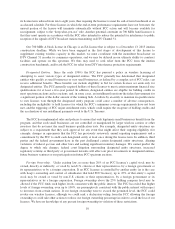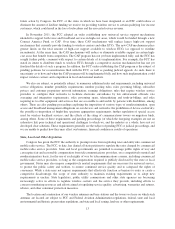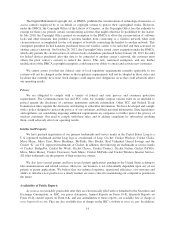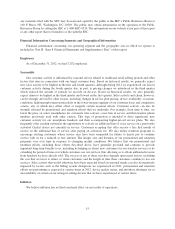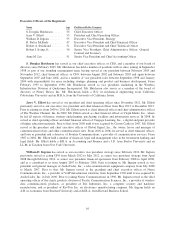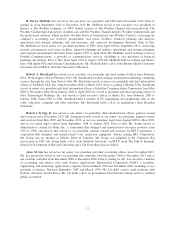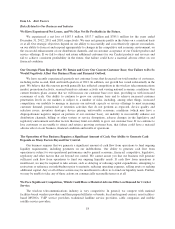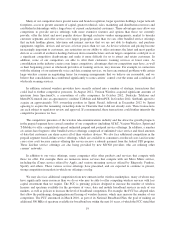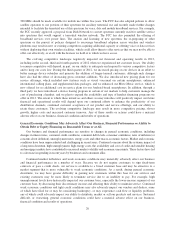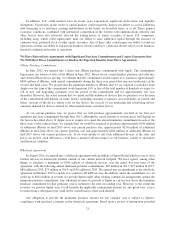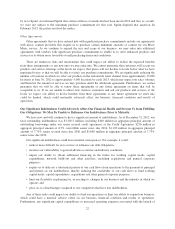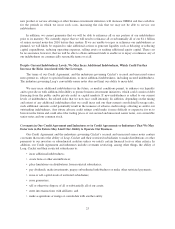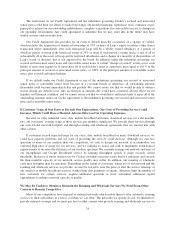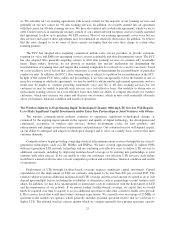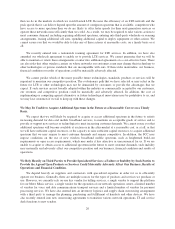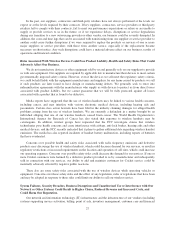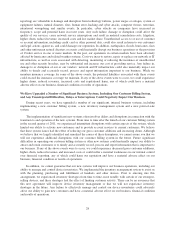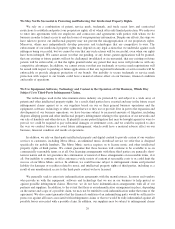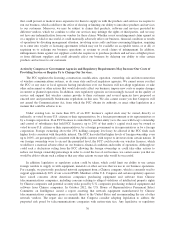Cricket Wireless 2012 Annual Report Download - page 34
Download and view the complete annual report
Please find page 34 of the 2012 Cricket Wireless annual report below. You can navigate through the pages in the report by either clicking on the pages listed below, or by using the keyword search tool below to find specific information within the annual report.300 MHz should be made available for mobile use within five years. The FCC has also adopted policies to allow
satellite operators to use portions of their spectrum for ancillary terrestrial use and recently made further changes
intended to facilitate the terrestrial use of this spectrum for voice, data and mobile broadband services. For example,
the FCC recently approved a proposal from Dish Network to convert spectrum currently used for satellite service
into spectrum that would support a terrestrial wireless network. The FCC has also permitted the offering of
broadband services over power lines. The auction and licensing of new spectrum, the re-purposing of other
spectrum or the pursuit of policies designed to encourage broadband adoption across wireline and wireless
platforms may result in new or existing competitors acquiring additional capacity or offering voice or data services
without deploying their own wireless facilities, which could allow them to offer services that we may not be able to
offer cost effectively, or at all, with the licenses we hold or to which we have access.
The evolving competitive landscape negatively impacted our financial and operating results in 2012,
including in the second, third and fourth quarters of 2012 when we experienced net customer losses. Our ability
to remain competitive will depend, in part, on our ability to anticipate and respond to various competitive factors
and to keep our costs low. During the third quarter of 2012, we increased pricing on our devices in an effort to
better manage device subsidies and promote the addition of longer-tenured customers, although such changes
have also had the effect of decreasing gross customer additions. We also introduced new pricing plans for our
service offerings, which included new features such as visual voicemail on certain smartphones, enhanced
international calling plans, and supplemental data packages, and we enhanced our Muve Music service, which is
now offered for no additional cost in service plans for our Android-based smartphones. In addition, through a
third party we have introduced a device leasing program in certain of our markets to help customers manage the
cost of purchasing a handset, and we plan to expand the availability and type of handset financing programs we
offer in 2013. The extent to which these initiatives and others we may introduce will positively impact our future
financial and operational results will depend upon our continued efforts to enhance the productivity of our
distribution channels, continued customer acceptance of our product and service offerings, and our ability to
retain these customers. The evolving competitive landscape may result in more competitive pricing, slower
growth, higher costs and increased customer turnover. Any of these results or actions could have a material
adverse effect on our business, financial condition and results of operations.
General Economic Conditions May Adversely Affect Our Business, Financial Performance or Ability to
Obtain Debt or Equity Financing on Reasonable Terms or at All.
Our business and financial performance are sensitive to changes in general economic conditions, including
changes in interest rates, consumer credit conditions, consumer debt levels, consumer confidence, rates of inflation (or
concerns about deflation), unemployment rates, energy costs and other macro-economic factors. Market and economic
conditions have been unprecedented and challenging in recent years. Continued concerns about the systemic impact of
a long-term downturn, high unemployment, high energy costs, the availability and cost of credit and unstable housing
and mortgage markets have contributed to increased market volatility and economic uncertainty. These factors have led
to a decrease in spending in recent years by businesses and consumers alike.
Continued market turbulence and weak economic conditions may materially adversely affect our business
and financial performance in a number of ways. Because we do not require customers to sign fixed-term
contracts or pass a credit check, our service is available to a broad customer base and may be attractive to a
market segment that is more vulnerable to weak economic conditions. As a result, during general economic
downturns, we may have greater difficulty in gaining new customers within this base for our services and
existing customers may be more likely to terminate service due to an inability to pay. For example, high
unemployment levels have historically impacted our customer base, especially the lower-income segment of our
customer base, by decreasing their discretionary income and affecting their ability to maintain service. Continued
weak economic conditions and tight credit conditions may also adversely impact our vendors and dealers, some
of which have filed for or may be considering bankruptcy, or may experience cash flow or liquidity problems,
any of which could adversely impact our ability to distribute, market or sell our products and services. Sustained
difficult, or worsening, general economic conditions could have a material adverse effect on our business,
financial condition and results of operations.
20


